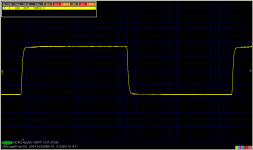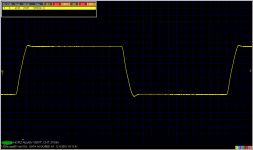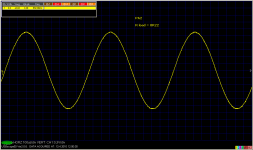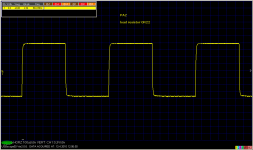Many local feedback, overall feedback... 20kHz, 110V p-p into eight...mosfet amp with EC...little bit smoother, isn't it true ? 😎
Attachments
Last edited:
... 20kHz, 110V p-p into eight...mosfet amp with EC...little bit smoother, isn't it true ? 😎
Was measured at 4Ω or 2μF?
4 Ohm : yes, practically the same result, only little bit slower...
Thus, measured without load.
Why without load ? Are you prefer to use amplifiers without any load ?
Pleas, send here overcurrent protection test in your "HQQF" - 500W or 1000W amplifier, full supply voltage, 400Hz sinewave, 80% output voltage with no load and with load 0,1 ohm, 5-10 sec duration. Storage scope is recommended.
Pleas, send here overcurrent protection test in your "HQQF" - 500W or 1000W amplifier, full supply voltage, 400Hz sinewave, 80% output voltage with no load and with load 0,1 ohm, 5-10 sec duration. Storage scope is recommended.
Pleas, send here overcurrent protection test in your "HQQF" - 500W or 1000W amplifier, full supply voltage, 400Hz sinewave, 80% output voltage with no load and with load 0,1 ohm, 5-10 sec duration. Storage scope is recommended.
To the impossible!
Current will be limited to less than 20A. Voltage on the load will be less than 2V. After a few ms off fuse!
Thus, measured without load.
He said "into eight", that means 8 ohm.
To the impossible!
Current will be limited to less than 20A. Voltage on the load will be less than 2V. After a few ms off fuse!
Impossible, than in 0,1R load may be less than 2V, oh no ? I"m waiting how are your overcurrent protections exact. You may set output voltage at 4-6V with no load and than test it with 0,1 ohms. 🙄
We are not talking about "each amplifier", but about "your HQQF" amplifier. You have a new revolutionary design, as you wrote, then all world is waiting for results...
80% output voltage with no load and with load 0,1 ohm, 5-10 sec duration.
then all world is waiting for results...
I repeat that a normal person can not operate long into the amplifier to short-circuit.
I repeat that a normal person can not operate long into the amplifier to short-circuit.
This is an interesting question, Mr. Federmann, and I have decided to perform a similar test. Attached is a screenshot of measurement of PA2 amplifier, load resistor is 0R22 (0.22 ohm), sinewave at 1kHz:
Attachments
Federmann, your replies are only proclamation without testification. Proclamation and simulation are not reality, are you understand ?
This is an interesting question, Mr. Federmann, and I have decided to perform a similar test. Attached is a screenshot of measurement of PA2 amplifier, load resistor is 0R22 (0.22 ohm), sinewave at 1kHz:
80% output voltage with no load and with load 0,1 ohm, 5-10 sec duration.
3.28 V p-p is full capacity?
3.28 V p-p is full capacity?
Oh no, but PA2 is only 2 x 55W amplifier. I assume that Sendy was meaning your 1kW amplifier (you have 20x more power than PA2), which is much more capable to yield high currents.
Impossible, than in 0,1R load may be less than 2V, oh no ? I"m waiting how are your overcurrent protections exact. You may set output voltage at 4-6V with no load and than test it with 0,1 ohms. 🙄
Mr. Federmann, Sendy is suggesting you to check your current protection by this way (he probably means your zener diode current protection).
Best regards,
Current proections are not absolutly necessary if the amp
is to be used in an audiophile purpose, provided the output
stage is rugged enough to easily deal with impedance dips
and reactive loads.
It just happen that Federmann s amp is used by a band, as
PA system , and in such case, it s better to have a functionnal
protection,both current and temperature , since the amp is going
to be used in rough conditions..
is to be used in an audiophile purpose, provided the output
stage is rugged enough to easily deal with impedance dips
and reactive loads.
It just happen that Federmann s amp is used by a band, as
PA system , and in such case, it s better to have a functionnal
protection,both current and temperature , since the amp is going
to be used in rough conditions..
- Status
- Not open for further replies.
- Home
- Amplifiers
- Solid State
- Influence of the delay amplifiers for listening characteristics




